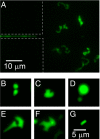Bacterial growth and motility in sub-micron constrictions
- PMID: 19706420
- PMCID: PMC2729279
- DOI: 10.1073/pnas.0907542106
Bacterial growth and motility in sub-micron constrictions
Abstract
In many naturally occurring habitats, bacteria live in micrometer-size confined spaces. Although bacterial growth and motility in such constrictions is of great interest to fields as varied as soil microbiology, water purification, and biomedical research, quantitative studies of the effects of confinement on bacteria have been limited. Here, we establish how Gram-negative Escherichia coli and Gram-positive Bacillus subtilis bacteria can grow, move, and penetrate very narrow constrictions with a size comparable to or even smaller than their diameter. We show that peritrichously flagellated E. coli and B. subtilis are still motile in microfabricated channels where the width of the channel exceeds their diameters only marginally (approximately 30%). For smaller widths, the motility vanishes but bacteria can still pass through these channels by growth and division. We observe E. coli, but not B. subtilis, to penetrate channels with a width that is smaller than their diameter by a factor of approximately 2. Within these channels, bacteria are considerably squeezed but they still grow and divide. After exiting the channels, E. coli bacteria obtain a variety of anomalous cell shapes. Our results reveal that sub-micron size pores and cavities are unexpectedly prolific bacterial habitats where bacteria exhibit morphological adaptations.
Conflict of interest statement
The authors declare no conflict of interest.
Figures






References
-
- Ranjard L, Richaume AS. Quantitative and qualitative microscale distribution of bacteria in soil. Res Microbiol. 2001;152:707–716. - PubMed
-
- Hahn MW. Broad diversity of viable bacteria in ‘sterile’ (0.2 μm) filtered water. Res Microbiol. 2004;155:688–691. - PubMed
-
- Wang Y, Hammes F, Boon N, Egli T. Quantification of the filterability of freshwater bacteria through 0.45, 0.22, and 0.1 μm pore size filters and shape-dependent enrichment of filterable bacterial communities. Environ Sci Technol. 2007;41:7080–7086. - PubMed
-
- do Nascimento C, et al. Bacterial leakage along the implant-abutment interface of premachined or cast components. Int J Oral Maxillofac Surg. 2008;37:177–180. - PubMed
Publication types
MeSH terms
LinkOut - more resources
Full Text Sources
Other Literature Sources

